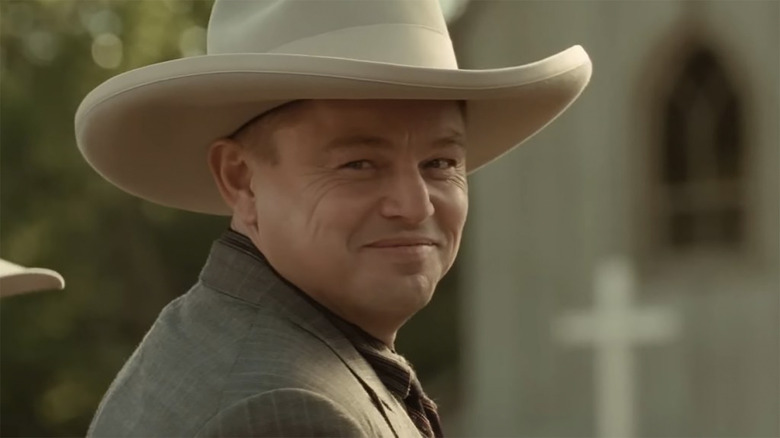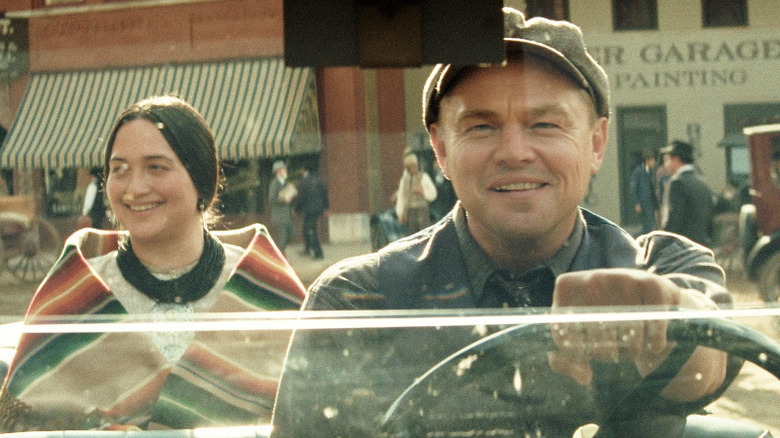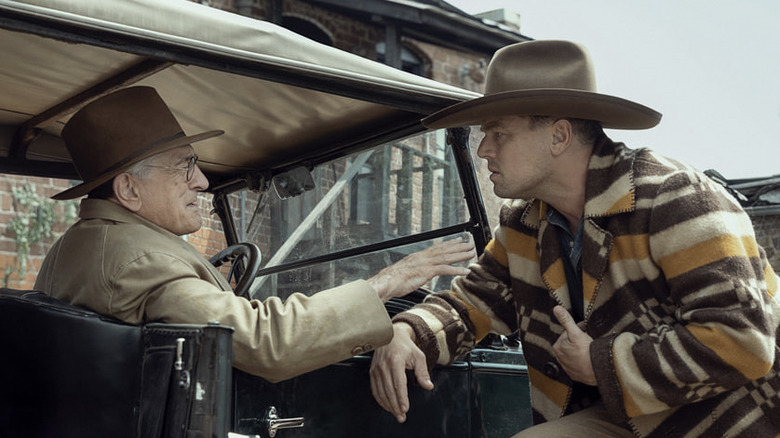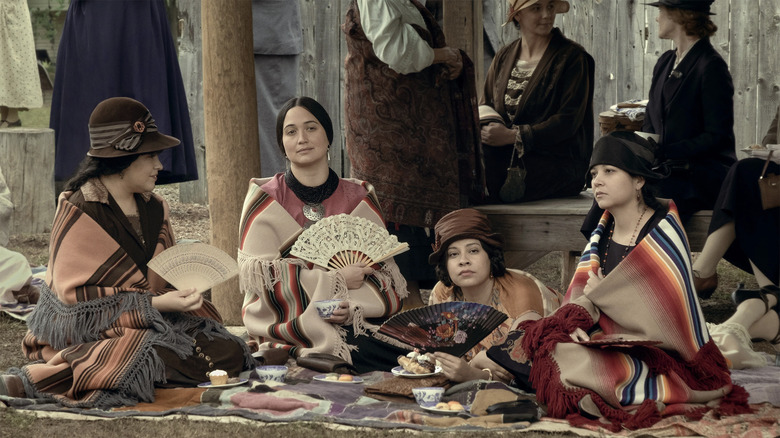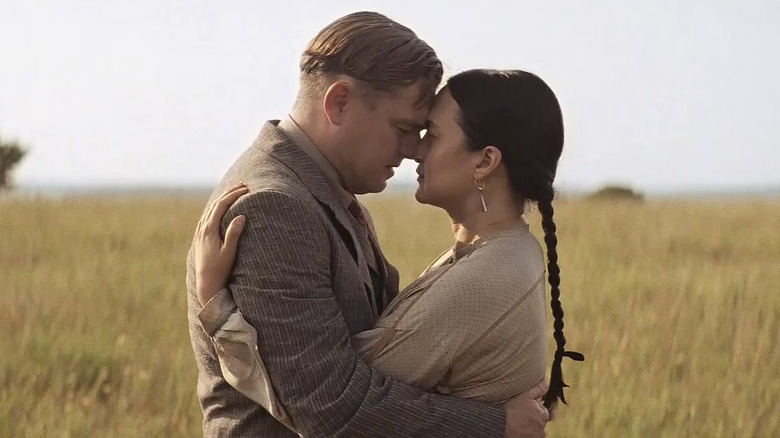Leonardo DiCaprio's Most Devilishly Charming Moment In Killers Of The Flower Moon Was Improvised
This article contains spoilers for "Killers of the Flower Moon."
Martin Scorsese's new movie "Killers of the Flower Moon" delivers another stirring teardown of the myth of American greatness. Behind many of the greatest success stories in America lie tragedy and cruelty, whether it's being inflicted by those rising to the top or eventually upon them after reality settles in. "Mean Streets," "GoodFellas," "Gangs of New York," "The Wolf of Wall Street," and many more have featured this theme in a variety of ways. However, what makes "Killers of the Flower Moon" different than the rest is that there's a genuine love story spoiled by all the manipulation, betrayal, extortion, and murder.
In the film, Leonardo DiCaprio plays Ernest Burkhart, a soldier who has recently returned from World War I and seeks out employment in the oil fields of Osage County in Oklahoma. Here, the land given to the Osage people runs rich with black gold, making them some of the wealthiest people on the planet, and providing an opportunity for scheming white men to cheat them out of what is rightfully their land and fortune, as is the American way. Rather than working in the oil fields, Burkhart is recruited by his uncle, a wealthy rancher named William King Hale (Robert De Niro), who has gained the trust and friendship of the Osage people, to help him keep the lucrative land of Osage County within the Native American family by marrying into one of them. But what Hale is really trying to do is take the land out from under the Osage people, as Burkhart isn't the only young white man he's encouraging to marry into the Osage line.
However, there's an extra layer of tragedy in the case of Ernest Burkhart's deception and betrayal, because before he was ever recruited by Hale, Burkhart had already taken a genuine liking to an Osage woman named Mollie (Lily Gladstone), the same woman that his uncle would eventually encourage him to betroth and betray.
'...but it must've been Indian for handsome devil'
When Ernest meets Mollie, he's trying to make some cash by being a taxi drive around Osage County. He catches her walking through town and offers her a ride. Mollie is quiet and calm, she let's her face express more than her words ever might. Ernest shows some of his more rascally tendencies, as he takes an interest in a sudden drag race through downtown, which distracts him from driving Mollie home for a moment. But as soon as they're on the road, he puts on the charm, but only slowly at first.
However, that natural attraction Ernest has for Mollie is thrown into overdrive when Hale reveals that he thinks it would be a good idea to "help the Osage people" by marrying into their family and ensuring that the recent rash of mysterious deaths of Osage people doesn't result in their land being taken away from them. At least that's what Hale tells Burkhart, who is more than a bit gullible and easily manipulated. That's when Burkhart pulls out all the stops and makes it clear that he's interested in Mollie romantically.
Acting as her regular driver around town, he's much more direct about pursuing her. When he questions her about another potential romantic interest in her life, he mentions just wanting to know who else is in this horse race. Mollie responds with words in the Osage language, which Ernest doesn't understand. Mollie repeats it, and Ernest responds, with a flirtatious grin on his face, "Well, I don't know what that was, but it must've been Indian for handsome devil," which prompts Mollie to laugh in amusement.
During a recent press conference in support of "Killers of the Flower Moon," director Martin Scorsese revealed that this was an improvised moment. In fact, Lily Gladstone's laugh in response to the line is genuine. As Scorsese said, "So that moment you have the actual relationship, it's actually between the two actors." And that was a key moment that resonates throughout the entire film, because even as Ernest continually lies and betrays Mollie, he still genuinely loves her and believes what he's doing is for their own good.
'It's a love story'
The press conference with Scorsese also revealed what the filmmaker learned when he visited Osage County. All these years later, descendants of both the Osage people and the Burkharts still live there. Scorsese explained:
"What I didn't really understand in the first couple of meetings [with the Osage people and descendants of the story] was that this is an ongoing situation, an ongoing story out in Oklahoma. In other words, these are things that really weren't talked about in the generation I was talking to and the generation above them. Before them, I should say. It was the generation before them that this happened to. So they didn't talk about it much. The people involved are still there, meaning the families are still there, the descendants are still there. So what I learned from meeting with them, having dinners with them — Margie Burkhart, she was the relative of Ernest Burkhart. She pointed out, and a number of other people pointed out, that you have to understand, a lot of the white guys there, a lot of the European Americans, particularly Bill Hale, they were good friends."
It's that relationship that allowed the Osage people to be so easily manipulated without their knowledge, and the romance between Ernest and Mollie is just another casualty of that. However, Scorsese said that Margie Burkhart emphasized the real romance that was there between Ernest and Mollie:
"She said, 'One has to remember that Ernest,' her ancestor, 'loved Mollie. And Mollie loved Ernest. It's a love story." Ultimately, what happened is that the script shifted that way, and that's when Leo decided to play Ernest instead of Tom White."
'Why don't we just show that's how it could happen?'
Initially, Leonardo DiCaprio was going to play Tom White, the agent from the Bureau of Investigation (which would become the FBI) who is sent to solve the murders in Osage County. But that was when the script was more focused on the birth of the FBI rather than the story as it unfolds from within the Osage community. As Scorsese uncovered the heart of the story within the Osage people, he found a new approach, one that allowed him to cut to the core of their plight and show people how these Native American people were destroyed from within by greedy coyotes. So DiCaprio became Ernest, and Jesse Plemons stepped into the role of Tom White, a character who now doesn't roll into the story until about halfway through the movie.
What makes the story all the more heartbreaking is that many of the Osage people were aware that plenty of white men in their community were looking for money, but they didn't let that keep them from pursuing what still felt like true love. Scorsese discussed how scenes depicting the evolution of this terrible deception came about. During one scene where Lily and Ernest have dinner by themselves for the first time, Mollie laughs to herself and comments, "Coyote wants money," and Ernest surprisingly confirms, "That's right, I love money." Scorsese explained:
"So she knows. This is the other thing, she knows what she's getting into. Even her sisters later, which is also a scene that we put in with the Osage, with the Native American actors. They said, 'What if we're talking about the guys while they're playing that game, and we're talking about my husband and talking about that guy with the blue eyes likes you. And, well, I don't think he just wants money. Well, it doesn't matter, he's nice. He wants to settle down.' Why don't we just show that's how it could happen? That's the way the script was ultimately created by these moments."
This is America
This is why the romance between Ernest and Mollie became the backbone of the story rather than focusing on the formation of the FBI. If Scorsese had put the focus on the crimes themselves and the investigation, it might not have felt much different from your average crime thriller. But with a doomed romance at its core, one brought to life by the beautiful chemistry between Lily Gladstone and Leonardo DiCaprio, there's even more suffering than what's on the surface. Using a charming actor like DiCaprio in this kind of role is the ultimate deception for the audience.
But it's Gladstone who delivers the most crushing blow, as the end of the film finds Mollie walking out on Ernest when he refuses to admit to her face that he kept her incapacitated for a time by poisoning her insulin doses. Even knowing what happened with her murdered sisters and other Osage deaths, that personal betrayal may sting even more for Mollie, because the love between her and Ernest was real.
So on top of the murders of many Osage people by a group of scheming white men just trying to make a buck, you have this love story that might have been something to cherish if it wasn't tainted by greed and death. Similarly, like many of Scorsese's other movies, "Killers of the Flower Moon" gives us a microcosm of America, a country that has been given a grand portrait that paints it as a shining example of freedom, greatness, and success, but in reality, it will always be stained by the blood of those who have been killed in the wake of our own hubris.
"Killers of the Flower Moon" is playing in select theaters now.
